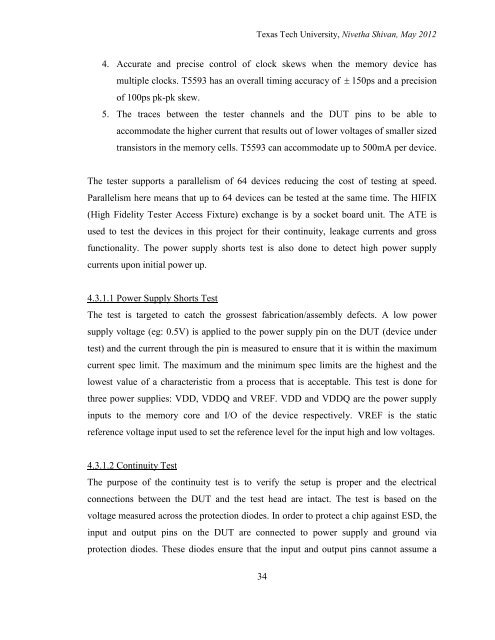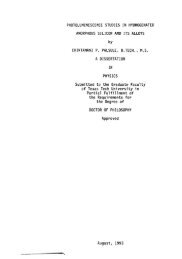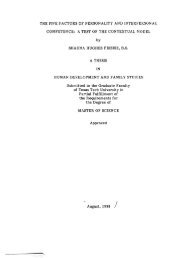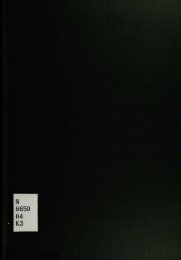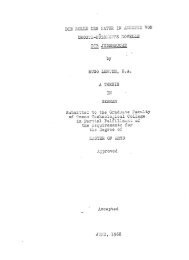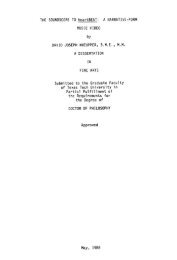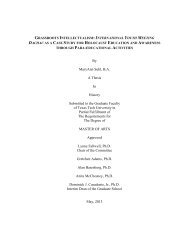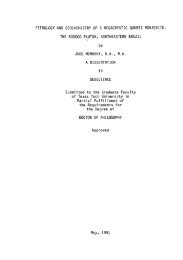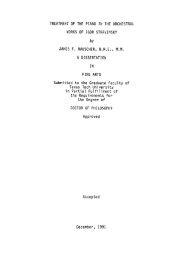Qualification of the Assembly Process of Flip-Chip BGA Packages ...
Qualification of the Assembly Process of Flip-Chip BGA Packages ...
Qualification of the Assembly Process of Flip-Chip BGA Packages ...
Create successful ePaper yourself
Turn your PDF publications into a flip-book with our unique Google optimized e-Paper software.
Texas Tech University, Nivetha Shivan, May 2012<br />
4. Accurate and precise control <strong>of</strong> clock skews when <strong>the</strong> memory device has<br />
multiple clocks. T5593 has an overall timing accuracy <strong>of</strong> � 150ps and a precision<br />
<strong>of</strong> 100ps pk-pk skew.<br />
5. The traces between <strong>the</strong> tester channels and <strong>the</strong> DUT pins to be able to<br />
accommodate <strong>the</strong> higher current that results out <strong>of</strong> lower voltages <strong>of</strong> smaller sized<br />
transistors in <strong>the</strong> memory cells. T5593 can accommodate up to 500mA per device.<br />
The tester supports a parallelism <strong>of</strong> 64 devices reducing <strong>the</strong> cost <strong>of</strong> testing at speed.<br />
Parallelism here means that up to 64 devices can be tested at <strong>the</strong> same time. The HIFIX<br />
(High Fidelity Tester Access Fixture) exchange is by a socket board unit. The ATE is<br />
used to test <strong>the</strong> devices in this project for <strong>the</strong>ir continuity, leakage currents and gross<br />
functionality. The power supply shorts test is also done to detect high power supply<br />
currents upon initial power up.<br />
4.3.1.1 Power Supply Shorts Test<br />
The test is targeted to catch <strong>the</strong> grossest fabrication/assembly defects. A low power<br />
supply voltage (eg: 0.5V) is applied to <strong>the</strong> power supply pin on <strong>the</strong> DUT (device under<br />
test) and <strong>the</strong> current through <strong>the</strong> pin is measured to ensure that it is within <strong>the</strong> maximum<br />
current spec limit. The maximum and <strong>the</strong> minimum spec limits are <strong>the</strong> highest and <strong>the</strong><br />
lowest value <strong>of</strong> a characteristic from a process that is acceptable. This test is done for<br />
three power supplies: VDD, VDDQ and VREF. VDD and VDDQ are <strong>the</strong> power supply<br />
inputs to <strong>the</strong> memory core and I/O <strong>of</strong> <strong>the</strong> device respectively. VREF is <strong>the</strong> static<br />
reference voltage input used to set <strong>the</strong> reference level for <strong>the</strong> input high and low voltages.<br />
4.3.1.2 Continuity Test<br />
The purpose <strong>of</strong> <strong>the</strong> continuity test is to verify <strong>the</strong> setup is proper and <strong>the</strong> electrical<br />
connections between <strong>the</strong> DUT and <strong>the</strong> test head are intact. The test is based on <strong>the</strong><br />
voltage measured across <strong>the</strong> protection diodes. In order to protect a chip against ESD, <strong>the</strong><br />
input and output pins on <strong>the</strong> DUT are connected to power supply and ground via<br />
protection diodes. These diodes ensure that <strong>the</strong> input and output pins cannot assume a<br />
34


